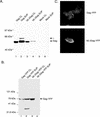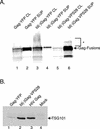Equine infectious anemia virus utilizes host vesicular protein sorting machinery during particle release
- PMID: 12857913
- PMCID: PMC165230
- DOI: 10.1128/jvi.77.15.8440-8447.2003
Equine infectious anemia virus utilizes host vesicular protein sorting machinery during particle release
Abstract
A final step in retrovirus assembly, particle release from the cell, is modulated by a small motif in the Gag protein known as a late domain. Recently, human immunodeficiency virus type 1 (HIV-1) and Moloney murine leukemia virus (M-MuLV) were shown to require components of the cellular vacuolar protein sorting (VPS) machinery for efficient viral release. HIV-1 interacts with the VPS pathway via an association of HIV-1 Gag with TSG101, a component of the cellular complexes involved in VPS. Equine infectious anemia virus (EIAV) is unique among enveloped viruses studied to date because it utilizes a novel motif, YPDL in Gag, as a late domain. Our analysis of EIAV assembly demonstrates that EIAV Gag release is blocked by inhibition of the VPS pathway. However, in contrast to HIV-1, EIAV Gag release is insensitive to TSG101 depletion and EIAV particles do not contain significant levels of TSG101. Finally, we demonstrate that fusing EIAV Gag directly with another cellular component of the VPS machinery, VPS28, can restore efficient release of an EIAV Gag late-domain mutant. These results provide evidence that retroviruses can interact with the cellular VPS machinery in several different ways to accomplish particle release.
Figures




Similar articles
-
Functional replacement and positional dependence of homologous and heterologous L domains in equine infectious anemia virus replication.J Virol. 2002 Feb;76(4):1569-77. doi: 10.1128/jvi.76.4.1569-1577.2002. J Virol. 2002. PMID: 11799151 Free PMC article.
-
AIP1/ALIX is a binding partner for HIV-1 p6 and EIAV p9 functioning in virus budding.Cell. 2003 Sep 19;114(6):689-99. doi: 10.1016/s0092-8674(03)00653-6. Cell. 2003. PMID: 14505569
-
Late domain-dependent inhibition of equine infectious anemia virus budding.J Virol. 2004 Jan;78(2):724-32. doi: 10.1128/jvi.78.2.724-732.2004. J Virol. 2004. PMID: 14694104 Free PMC article.
-
HIV capsid assembly.Curr HIV Res. 2003 Jan;1(1):1-14. doi: 10.2174/1570162033352084. Curr HIV Res. 2003. PMID: 15043208 Review.
-
[HIV budding and Tsg101].Uirusu. 2005 Dec;55(2):281-6. doi: 10.2222/jsv.55.281. Uirusu. 2005. PMID: 16557014 Review. Japanese.
Cited by
-
Foot-and-mouth disease virus downregulates vacuolar protein sorting 28 to promote viral replication.J Virol. 2023 Aug 31;97(8):e0018123. doi: 10.1128/jvi.00181-23. Epub 2023 Aug 11. J Virol. 2023. PMID: 37565750 Free PMC article.
-
Distinct intracellular trafficking of equine infectious anemia virus and human immunodeficiency virus type 1 Gag during viral assembly and budding revealed by bimolecular fluorescence complementation assays.J Virol. 2007 Oct;81(20):11226-35. doi: 10.1128/JVI.00431-07. Epub 2007 Aug 8. J Virol. 2007. PMID: 17686839 Free PMC article.
-
YRKL sequence of influenza virus M1 functions as the L domain motif and interacts with VPS28 and Cdc42.J Virol. 2006 Mar;80(5):2291-308. doi: 10.1128/JVI.80.5.2291-2308.2006. J Virol. 2006. Retraction in: J Virol. 2006 Oct;80(20):10289. doi: 10.1128/JVI.01632-06. PMID: 16474136 Free PMC article. Retracted.
-
Context-dependent effects of L domains and ubiquitination on viral budding.J Virol. 2004 Jun;78(11):5554-63. doi: 10.1128/JVI.78.11.5554-5563.2004. J Virol. 2004. PMID: 15140952 Free PMC article.
-
Equine Infectious Anemia Virus Gag Assembly and Export Are Directed by Matrix Protein through trans-Golgi Networks and Cellular Vesicles.J Virol. 2015 Dec 4;90(4):1824-38. doi: 10.1128/JVI.02814-15. Print 2016 Feb 15. J Virol. 2015. PMID: 26637458 Free PMC article.
References
-
- Babst, M., D. J. Katzmann, E. J. Estepa-Sabal, T. Meerloo, and S. D. Emr. 2002. ESCRT-III: an endosome-associated heterooligomeric protein complex required for MVB sorting. Dev. Cell 3:271-282. - PubMed
-
- Babst, M., D. J. Katzmann, W. B. Snyder, B. Wendland, and S. D. Emr. 2002. Endosome-associated complex, ESCRT-II, recruits transport machinery for protein sorting at the multivesicular body. Dev. Cell 3:283-289. - PubMed
-
- Berlioz-Torrent, C., B. L. Shacklett, L. Erdtmann, L. Delamarre, I. Bouchaert, P. Sonigo, M. C. Dokhelar, and R. Benarous. 1999. Interactions of the cytoplasmic domains of human and simian retroviral transmembrane proteins with components of the clathrin adaptor complexes modulate intracellular and cell surface expression of envelope glycoproteins. J. Virol. 73:1350-1361. - PMC - PubMed
Publication types
MeSH terms
Substances
Grants and funding
LinkOut - more resources
Full Text Sources
Other Literature Sources
Molecular Biology Databases

